
Improve posture, lessen pain, and manage scoliosis naturally with these easy, powerful moves.
Scoliosis [1] — that unnatural sideways spinal curve that sneaks up on posture and spinal health — doesn’t just affect the back. It can lead to tight muscles, chronic back pain, and a cascade of issues affecting spinal mobility, balance, and even breathing.
Whether you’re dealing with mild scoliosis, lumbar scoliosis [2], or thoracic scoliosis, incorporating scoliosis-specific exercises into your daily home exercise program is key. These exercises target the core muscles, abdominal muscles, and surrounding muscles to help improve spinal alignment, relieve pressure on joints, and reduce muscle imbalances.
Before we get into the science of scoliosis treatment, let’s look at the best stretches you can do right now.
Best Stretches for Scoliosis: Step-by-Step (with Proper Technique)
All stretches below can be done on an exercise mat using just your body weight. Be sure to consult a physical therapist or corrective exercise specialist if you’re unsure about the treatment efficacy for your curve.
1. Pelvic Tilts
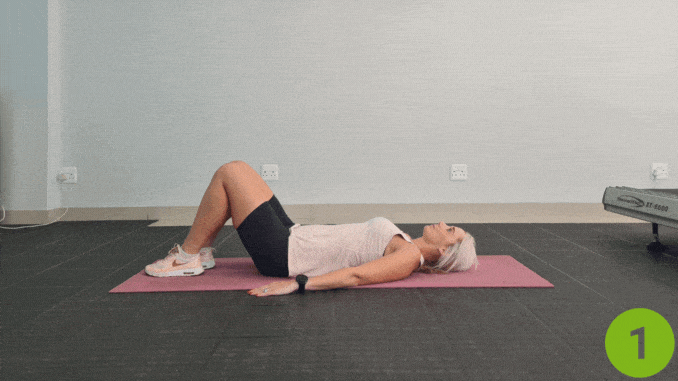
Best for: Lumbar scoliosis, improving spinal flexibility, and reducing low back tension.
- Lie on your back with your knees bent and your feet flat on the floor, relaxing your upper body.
- Place your hands at your side. Squeeze your pelvic floor muscles and tilt your pelvis backwards, pressing your lower back into the floor.
- Hold this position for several deep belly breaths, in through your nose and out through your mouth.
- Relax and return to the starting position.
10 reps, 1–2 sets.
2. Superman

Great for: Strengthening spinal extensor muscles, improving posture, and building upper body awareness.
- Lie on your stomach on the floor with your legs extended and your arms overhead.
- Engage your core muscles. Lift your arms and legs slightly off the floor.
- Hold the position for several deep belly breaths, in through your nose and out through your mouth.
- Relax and repeat the movement.
10 reps, 1–2 sets.
3. Cat-Cow Stretch
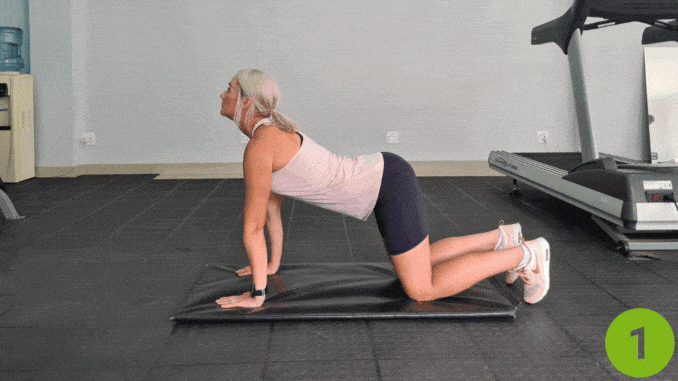
Ideal for: Mobilizing the thoracic and lumbar spine and encouraging spinal flexibility.
- Begin in a 4-point position with your hands beneath your shoulders and your knees under your hips.
- Contract your abdominal area. Inhale and slowly raise your head as you arch your mid-back.
- Exhale and lower your head down, rounding out your mid-back.
- Repeat the sequence of movements with 5 repetitions.
10 reps each direction.
4. Bird-Dog
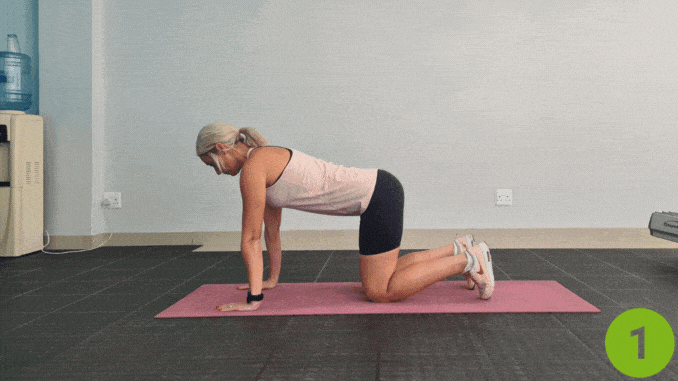
Targets: Core stability, single-leg balance, and coordination across muscle groups.
- Begin in a 4-point position, with your hands underneath your shoulders and your knees underneath your hips.
- Contract your abdominal area. Take a deep breath and lift one arm to align with your shoulder as you extend your opposite leg behind your body.
- Keep your hips and shoulders parallel to the floor.
- Hold the position for several deep belly breaths, in through your nose and out through your mouth.
- Relax and repeat the movement on the opposite side
10 reps on each side.
5. Latissimus Dorsi Stretch
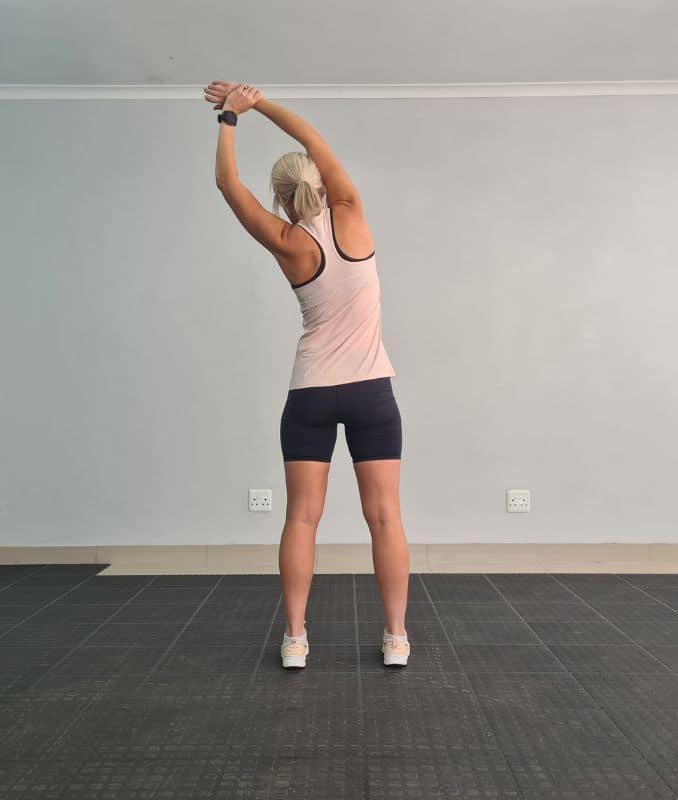
Helps improve: Spinal alignment, flexibility in the upper body, and elongates the tight muscles on the convex side of the curve.
- Begin in an upright standing position with your feet shoulder width apart, maintain good alignment with your head, shoulders, hips, and legs.
- Raise both hands overhead.
- Grab your left wrist with your right hand.
- Engage your core muscles. Lean left until you feel a stretch on your right side.
- Hold the position for several deep belly breaths, in through your nose and out through your mouth.
- Relax and repeat the movement on the opposite side.
10 reps on each side.
6. Abdominal Press
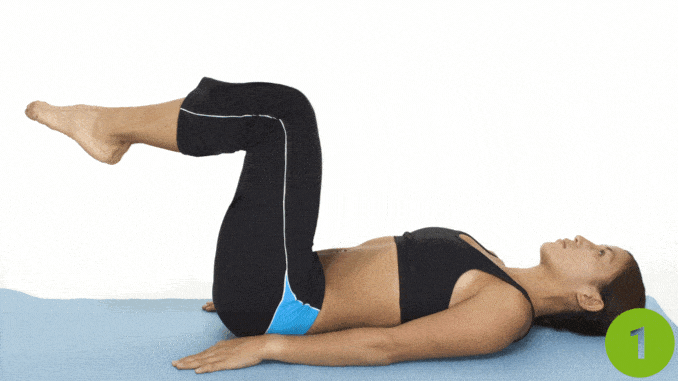
Strengthens: Abdominal muscles, corrects muscle imbalances, and supports spinal health.
- Lie on your back on the floor with your knees bent and feet flat on the floor.
- Place your hands on your sides.
- Engage your core muscles. Raise legs to tabletop (90° angle).
- Press hands into your thighs just above the knees while pushing your thighs back into your hands — no joint movement. Focus on strengthening core muscles.
- Hold the position for several deep belly breaths in through your nose and out through your mouth.
- Repeat the movement with 10 repetitions.
7. Bonus: Water-Based Corrective Exercise
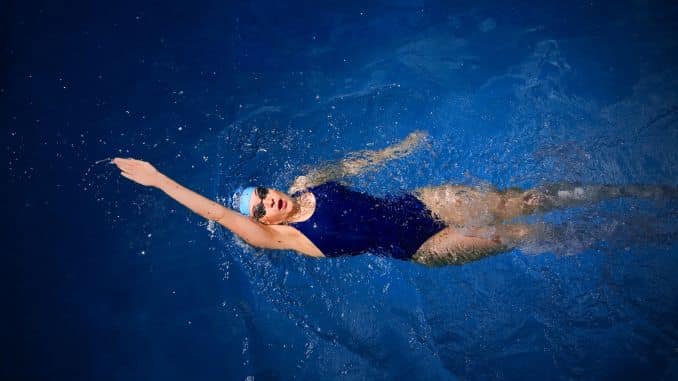
Inspired by clinical studies and Schroth exercises, perfect for severe cases and spinal decompression.
- Swim backstroke with a kickboard supporting the thoracic spine.
- Use scissor kicks or float-assisted motions.
- Finish with a whirlpool or warm water massage for pain relief.
These scoliosis stretches are especially effective in managing curve progression for scoliosis patients of all ages.
The Science Behind the Stretch
Studies have shown that certain exercises, when done consistently, can lead to:
- A 17% improvement in cardiovascular capacity
- Increased spine length and better shoulder mobility
- Stronger erector spinae and core muscles
Pairing these stretches with physical therapy, chiropractic treatment, or even guided plank exercises enhances treatment efficacy, especially in structural scoliosis.
How to Manage Scoliosis Effectively?
Include:
- Daily scoliosis workout routines
- Core-strengthening and upper body mobility drills
- Breathing exercises to enhance lung expansion
- Regular consultation with a corrective exercise specialist
Avoid:
- High-impact movements that strain the spine
- Neglecting signs like back pain, fatigue, or imbalance
- Poor posture habits — always practice good posture!
For individuals with muscular dystrophy [3] or complex curves, always work closely with a physical therapist for a tailored plan.
According to Dr. Sabrina Strickland, M.D., Orthopedic Surgeon at Hospital for Special Surgery (HSS), New York “Stretching and strengthening exercises tailored to the individual’s curve can help reduce pain and improve function. For example, side stretches and poses like the child’s pose or cat-cow can help elongate the spine and relieve tightness.
Dr. Strickland emphasizes that while exercises don’t “cure” scoliosis, they are powerful tools to manage symptoms, improve posture, and support spinal mobility when done consistently and with proper form
Final Thoughts: Take Control of Your Spinal Health
Managing scoliosis doesn’t have to mean surgery or endless discomfort. With the best stretches for scoliosis, attention to good posture, and a consistent home exercise program, you can correct scoliosis naturally and improve your overall posture.
Chronic lower back pain can make life a misery. Your sleep is affected; you’re unable to run, do sports, or play with your kids or grandkids. What’s worse, nothing seems to make it better. Get fast relief from back pain and prevent your chances of having scoliosis with our Low Back Pain Solved!
FAQ’s
How can I straighten my scoliosis naturally?
Through targeted exercises like pelvic tilts and bird-dog, you can improve posture and spinal alignment. Consistency and guidance from a physical therapist are key.
Can I massage my scoliosis?
Yes, massage can relieve tight muscles and pain, but it won’t correct the curve. It’s best used alongside a proper exercise routine.
Is bed rest good for scoliosis?
No, prolonged rest can weaken support muscles. Gentle movement and stretching are more beneficial for managing scoliosis.

